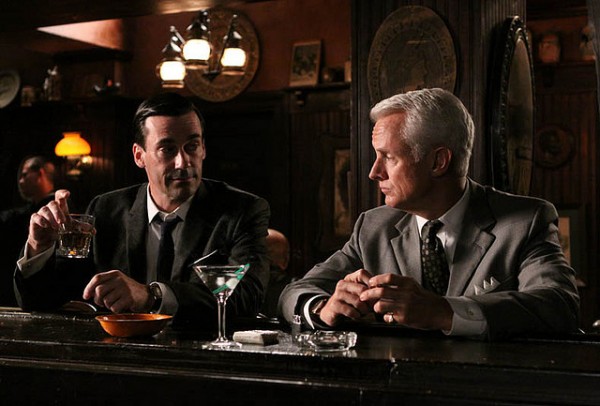
We hate it and we love it. Television is worse than ever and better than ever. Most of us can reel off the names of ten shows that we consider brilliant. Many of us can do the same for ten shows that are abominable. So what’s really happening out there in our culture–are the forces of good TV triumphing, or are they losing to the forces of garbage? It’s not always easy to tell. In advance of “Is This the Golden Age of Television?“, a Zócalo event, we asked several television mavens to answer a simple question: Is this the “Golden Age” of television?
Maybe yes, but shhh–you’ll jinx it
To call this a “golden age of television” seems to tempt fate. Aren’t such epochs supposed to be evident only in hindsight? What is clear is that we are witnessing–and have been for many TV seasons now–the elevation of certain types of television from idiot box to respectable medium. As TV acting, writing, and cinematography rivals the big screen, critics take it increasingly seriously–perhaps too seriously, judging by the overwhelming amount of Mad Men coverage that will accompany the show’s sixth season.
 Of course, reality TV is also sinking to new lows, and I say this not with disdain, as I’m an avid viewer of Real Housewives. (I didn’t want to like Brandi, but I do!) Indeed, I think that this bifurcation is the truly interesting phenomenon. Aside from a few sitcoms, we are seeing the death of the middlebrow. Television is instead being divided into the high and the low. The highbrow can be a bit campy, as with True Blood, and the lowbrow can aspire to be something it isn’t, like Teen Mom’s purported goal to educate kids about safe sex. But whether it’s high or low, it’s never boring.
Of course, reality TV is also sinking to new lows, and I say this not with disdain, as I’m an avid viewer of Real Housewives. (I didn’t want to like Brandi, but I do!) Indeed, I think that this bifurcation is the truly interesting phenomenon. Aside from a few sitcoms, we are seeing the death of the middlebrow. Television is instead being divided into the high and the low. The highbrow can be a bit campy, as with True Blood, and the lowbrow can aspire to be something it isn’t, like Teen Mom’s purported goal to educate kids about safe sex. But whether it’s high or low, it’s never boring.
There is one sign that we are in, or hovering around the edges of, a golden age: the laugh track seems to be gasping out its last forced guffaws. For that, I am truly grateful.
Torie Bosch is the editor of Future Tense, a joint project of Slate, the New America Foundation, and Arizona State University.
————————————-
Yes and no: it’s more golden, more silver, more crappy–and just more
 The late Robert M. Batscha, longtime president of The Paley Center for Media, had a rule: never ever, refer to the 1950s–the era of Chayefsky, Kovacs, Caesar, Morrow, and Ball–as the “golden age of television.” His reasoning: how could anything that included The Lawrence Welk Show, two nights a week of prime-time roller derby, and the calamitous game show You’re in the Picture (host Jackie Gleason once said it made the H-bomb “look like a two-inch salute”) be golden? Alas, such is the intractable truth of television programming history: it is always the best of times and worst of times. The sixties? The Defenders, Twilight Zone, Star Trek, The Dick Van Dyke Show, The Smothers Brothers Comedy Hour, but also The Beverly Hillbillies and The Flying Nun. The seventies gave us “relevant” comedies, from Norman Lear to MTM, and kick-ass dramas like Kolchak: The Night Stalker and The Rockford File. But it also gave us jiggle TV and, God help us, Dick Van Patten as a sagacious patriarch. The eighties launched what Syracuse professor Robert Thompson dubbed “Television’s Second Golden Age,” with quality dramas typified by fractured narratives, ambiguous morality, and self-reference. The great hospital drama St. Elsewhere is hailed as the paradigmatic example, and, yuks-wise, this was the age of The Cosby Show, Roseanne, and Letterman. But it was also the age of–dare I say it?–Mama’s Family. You get the point.
The late Robert M. Batscha, longtime president of The Paley Center for Media, had a rule: never ever, refer to the 1950s–the era of Chayefsky, Kovacs, Caesar, Morrow, and Ball–as the “golden age of television.” His reasoning: how could anything that included The Lawrence Welk Show, two nights a week of prime-time roller derby, and the calamitous game show You’re in the Picture (host Jackie Gleason once said it made the H-bomb “look like a two-inch salute”) be golden? Alas, such is the intractable truth of television programming history: it is always the best of times and worst of times. The sixties? The Defenders, Twilight Zone, Star Trek, The Dick Van Dyke Show, The Smothers Brothers Comedy Hour, but also The Beverly Hillbillies and The Flying Nun. The seventies gave us “relevant” comedies, from Norman Lear to MTM, and kick-ass dramas like Kolchak: The Night Stalker and The Rockford File. But it also gave us jiggle TV and, God help us, Dick Van Patten as a sagacious patriarch. The eighties launched what Syracuse professor Robert Thompson dubbed “Television’s Second Golden Age,” with quality dramas typified by fractured narratives, ambiguous morality, and self-reference. The great hospital drama St. Elsewhere is hailed as the paradigmatic example, and, yuks-wise, this was the age of The Cosby Show, Roseanne, and Letterman. But it was also the age of–dare I say it?–Mama’s Family. You get the point.
Now, what of today? Is it television’s “Third Golden Age”? Or its first and only true golden age? Or just business as usual? There’s an argument going around that The Sopranos changed television forever, and The New York Times recently identified a number of acclaimed writers–Jonathan Franzen and Salman Rushdie among them–now scripting for the small screen. Frankly, I am not so moved by this. Sixty years ago Paddy Chayefsky, Rod Serling, and Reginald Rose wrote for television. Fifteen years ago, during the age of Homicide and NYPD Blue, the Times ran a similar piece, arguing that serialized television had supplanted the novel as our premier literary form. The story is not new. What is new is this: there are more channels today than ever before, and thus more programming. More of it is good, more of it is bad, and more of it is ugly.
David Bushman is television curator at The Paley Center for Media, a post he has held since 1992 (with a two-year break, when he served as program director at TV Land). Previously he was senior television editor of Daily Variety in Los Angeles and weekly Variety in New York. He has taught and lectured on TV at numerous institutions. He may be the only person in the world pining for an EZ Streets reunion.
————————————-
Yes–thanks to the magic of the Betamax (and its successors)
Anyone who sees the 1950s as television’s “Golden Age” might be surprised to hear we’re in the midst of another one. Yet we are.
 It began in 1984 with the Supreme Court’s “Betamax” ruling. The decision gave people permission to tape TV shows in their homes and fostered an explosion in home recording of TV programs. It also, indirectly, wound up encouraging the renting and buying of entire seasons of TV series.
It began in 1984 with the Supreme Court’s “Betamax” ruling. The decision gave people permission to tape TV shows in their homes and fostered an explosion in home recording of TV programs. It also, indirectly, wound up encouraging the renting and buying of entire seasons of TV series.
From a viewer perspective, having shows on tape permanently (if subtly at first) altered the fundamental perception of television. Before that, your access to any program, even your favorite, was at the whim of network programmers or syndicators. But once you could revisit individual episodes, or an entire series, at your own choosing, you could treat the entire medium with more respect. You didn’t have to remember a scene from years back. You could watch it again right away and appreciate its nuances
 As the canon of any series (or of individual program moments) became more accessible and manageable, program creators could change the assumptions of storytelling. It was no longer unreasonable to assume that viewers could roll back a tape (later DVR) for repeated playbacks. (Moonlighting; Wise Guy). This eventually led to more complex storytelling of the sort epitomized by The Wire.
As the canon of any series (or of individual program moments) became more accessible and manageable, program creators could change the assumptions of storytelling. It was no longer unreasonable to assume that viewers could roll back a tape (later DVR) for repeated playbacks. (Moonlighting; Wise Guy). This eventually led to more complex storytelling of the sort epitomized by The Wire.
Viewer control also changed the definition of a “season.” A run of six, eight, or 13 episodes is often more satisfying than material stretched to create 22 or, in the 1950s, 39 episodes per season. Shows can also be seen without commercials, stripped down to the best of the best.
But wait, isn’t there a lot of crap out there now? Yes, and there always has been. But even if the most popular series on television are shrill reality shows, dumb formula comedies, or violent action adventures, you can have a hard drive filled with your own Golden Age of Television lineup. Mad Men. Breaking Bad. Downton Abbey. The Daily Show. You’ve become your own TV programmer, enjoying what you want, when you want it. In this Golden Age, all of us can. Our TV viewing predecessors would be jealous.
Harry Castleman and Walter J. Podrazik are co-authors of Watching TV: Six Decades of American Television (Syracuse University Press). Castleman practices law in Boston. Podrazik is a communication and logistics consultant and also serves as consulting curator at Chicago’s Museum of Broadcast Communications and an adjunct lecturer at the University of Illinois at Chicago (Communication Department).
————————————-
Yes–it’s golden, but that’s been the case for decades now
 Critics and historians of the American media designated a “Golden Age of Television” a long time ago. It was defined as the period stretching from the late 1940s to the mid-1950s. What they found so “golden” about this era was that much of the programming was live and theater-based, and it originated out of New York. As production moved to Los Angeles and away from the aesthetics of live theater, many critics felt it had lost its dramaturgical pedigree. There was a good deal of pretentiousness at work here. For every golden hour like Marty or Patterns or Twelve Angry Men, there were hundreds of hours of really atrocious productions, including terrible adaptations of Shakespeare, Ibsen, and Shaw. But many intellectuals preferred bad live presentations of New York-based Shakespeare to the filmed sitcoms, Westerns, and crime shows that dominated the network schedules as the medium moved into more and more homes.
Critics and historians of the American media designated a “Golden Age of Television” a long time ago. It was defined as the period stretching from the late 1940s to the mid-1950s. What they found so “golden” about this era was that much of the programming was live and theater-based, and it originated out of New York. As production moved to Los Angeles and away from the aesthetics of live theater, many critics felt it had lost its dramaturgical pedigree. There was a good deal of pretentiousness at work here. For every golden hour like Marty or Patterns or Twelve Angry Men, there were hundreds of hours of really atrocious productions, including terrible adaptations of Shakespeare, Ibsen, and Shaw. But many intellectuals preferred bad live presentations of New York-based Shakespeare to the filmed sitcoms, Westerns, and crime shows that dominated the network schedules as the medium moved into more and more homes.
We are now in a second golden age of television, but it’s a continuation of a pattern that began over 30 years ago. In the early 1980s, the slow but sure fragmentation of the audience opened up some space for more specialized programming. This started out at the broadcast networks. While most cable channels were still showing movies, reruns, and sporting events, NBC introduced Hill Street Blues in January of 1981. This show set a template for a more literate, complex approach to television, with an emphasis on sophisticated serialization and a more cinematic interpretation of what was in the frame. Hill Street Blues was followed by an extraordinary run of series on all three major networks: shows like St. Elsewhere, Moonlighting, thirtysomething, Northern Exposure, and Twin Peaks. It would be several years before premium channels like HBO followed these examples of high quality television and several more before basic cable channels like FX and AMC continued the tradition. The Sopranos, Dexter, Breaking Bad, and Mad Men have a direct link to the innovations at the broadcast networks back in the 1980s. The “second golden age” that started in 1981 continues today.
As in any “golden age” of anything, the rarefied good stuff shares the cultural real estate with the not-so-good stuff. There were lots of bad novels written during Melville’s time; we just don’t read them anymore. And as William Daniels was starring in one of the best TV programs of all time, St. Elsewhere, he was also providing the voice of KITT on Knight Rider. There is more good TV on now than in any other time in the medium’s history; there is also more bad TV than ever before. There’s just more TV, period.
Robert Thompson is director of Bleier Center for Television and Popular Culture at Syracuse University.
————————————-
Yes–because it’s golden when elites want to call it golden
 Throughout U.S. television history, journalists, scholars, and cultural commentators have regularly criticized the medium, finding TV content to be a “vast wasteland,” “lowest common denominator,” a disgraceful display of our culture’s least impressive traits. But, today, while certain kinds of television are routinely disparaged–think Jersey Shore–other kinds of television are highly valued and awarded the status of art. This phenomenon is what my co-author Michael Z. Newman and I call the legitimation of television, a process we see as central to the way television is understood today.
Throughout U.S. television history, journalists, scholars, and cultural commentators have regularly criticized the medium, finding TV content to be a “vast wasteland,” “lowest common denominator,” a disgraceful display of our culture’s least impressive traits. But, today, while certain kinds of television are routinely disparaged–think Jersey Shore–other kinds of television are highly valued and awarded the status of art. This phenomenon is what my co-author Michael Z. Newman and I call the legitimation of television, a process we see as central to the way television is understood today.
In our book Legitimating Television, Newman and I don’t offer a yes or no answer to the question of whether this is a golden age of television. Instead, we analyze how we have come to admire the medium so much in the first place, given its long history of being disparaged. We argue that because only certain kinds of television are awarded the “golden age” designation–HBO series, single-camera sitcoms, certain serialized dramas–the “golden age” label affirms the tastes of elites. Moreover, elites set this “golden age” of programming apart from “TV” proper, so that “TV” officially remains a wasteland–except in cases where elite evaluators like what they’re seeing.
Elana Levine is associate professor at University of Wisconsin-Milwaukee.
————————————-
Yes–because it’s both gold and fool’s gold
 For television, this is indeed the best and worst of times–a Golden Age and Pyrite Period. While the unscripted genre is too diverse to speak of in sweeping generalities, some reality TV shows undeniably plumb new depths of abuse and humiliation, even as they spawn a generation of “stars” (see the Kardashians) whose only discernible talent is becoming famous.
For television, this is indeed the best and worst of times–a Golden Age and Pyrite Period. While the unscripted genre is too diverse to speak of in sweeping generalities, some reality TV shows undeniably plumb new depths of abuse and humiliation, even as they spawn a generation of “stars” (see the Kardashians) whose only discernible talent is becoming famous.
At the same time, there has never been such an abundance of great dramas, flanked by first-class comedies. Clearly, fans of great television–the kind that has, for many, replaced trips to the theatrical art house–owe a huge debt to HBO, which gave even snobs license to watch TV. The channel’s old “It’s not TV. It’s HBO” slogan perfectly captured this mentality, enabling readers (and critics) of The New Yorker and The New York Times to reference The Wire or The Sopranos with pride.
In hindsight, the pivotal moment in the modern quality explosion can be traced to the introduction of Nip/Tuck in 2003. The FX drama proved basic cable could aspire to a level of artistic ambition rivaling that of their upscale brethren. Programs like Mad Men and Damages followed, and network shows that would once have met untimely deaths (see NBC’s Friday Night Lights and Southland) found second lives on cable.
It’s also easy to forget there’s simply more of, well, everything–both good and bad, international (see Downton Abbey) and domestic. So yes, there are more goodies to squander one’s time than ever before. Yet an old adage still applies: all that glitters is not gold.
Brian Lowry is a columnist and critic for Variety.
*Photo courtesy of cwangdom.



